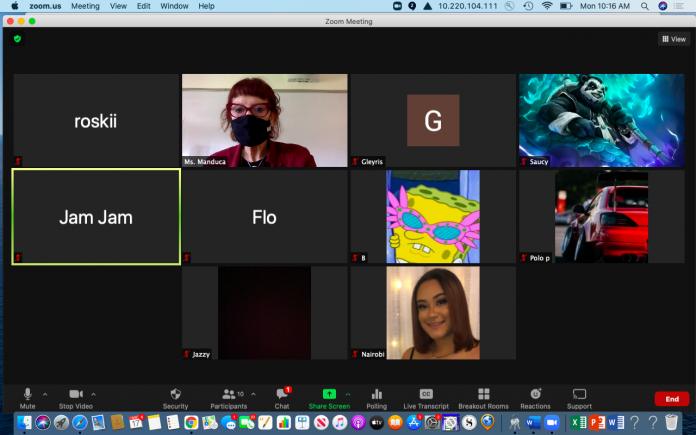I teach to Black Boxes.
At the beginning of the school year teaching psychology to high school seniors on Zoom was intimidating and confusing. Black boxes with names like “Saucy” and “Nugget” didn’t match my roster and with no visual cues, I couldn’t tell the difference between Kiana and Kiara. But I did understand protecting their privacy. A camera in your home is invasive. Some Boston students are homeless or live in crowded situations, and sometimes a teenager is just a teenager — self-conscious and easily embarrassed.
Yet, while these black boxes persisted, a few months into the year something extraordinary began to happen: I learned the sound of their voices. Subtle tones and pronunciations began to pair with names. Sometimes it wasn’t just the sound, but what a student said that cued me. For instance, when I heard, “This is stupid,” I knew it was Destiny. When I heard, “Good class, Miss,” I knew it was Manny.
I’m reminded of a TV show from my childhood called, “The Dating Game.” Behind a screen, anonymous bachelors were questioned by a bachelorette. The point of the game was to have her choose her date without seeing the person or knowing anything about him. She was left with a voice and responses to bizarre questions. I recently rewatched an old episode from 1968 with Steve Martin (before he was famous). The bachelorette asked, “If you had to be trapped in a store all night long, which store would you pick?” He picked Goodwill, and she picked him. Not only did she like his response, she liked the sound of his voice and his humor. It’s surprising how much of a person’s essence can be revealed in darkness.
When a student is struggling or behind, we meet one on one over Zoom. The black box remains. Like a confessional it offers privacy and intimacy. I remember feeling emboldened when I revealed things to a priest because of the simple fact that I couldn’t be seen. My students react the same way. At times like these I turn my own camera off and we become black boxes talking to each other, free of physical contrasts, and free of judgement.
Much to my chagrin, I realize that I have judged (or more precisely misjudged) students in the past. Like the girl who saunters in with dyed hair and heavy eye liner — right away, I like her; she looks like me. Or the boy who shrugs, lips snarling, eyes rolling back in his head, refusing to give me his name — I stereotype him as difficult and combative. The problem is that the second you see — your brain goes, click, click, click — and, beyond your control, your brain begins to label. She’s shy. He’s mean. Of course, you may be completely wrong, but what you see you believe, and it’s so difficult to unsee and realign and change your initial impression. With the black box, the old “first impression” is lost (and good riddance). Without visuals, everyone starts out equal. Same size, same color.
This winter, during a class discussion on colorism, the infamous brown paper bag test came up. As recently as the 1960’s, colleges and employers used this racist test to determine a person’s worth. A person lighter than the bag would be accepted. If darker, the person would be rejected. In other years this could be a hard discussion, but this year, the black box became a veil of anonymity. Students were free to tell their own stories of rejection, belittlement, persecution, and to listen to the stories of others. While the paper bag test limits a person on the basis of color, a visual, the black box is the opposite. It opens up the universe, making anything possible.
While students are nestled in their black box cocoons, I can’t see if someone is sleeping. I can’t see if they’re on their phones watching TikTok, posting on Instagram or checking notifications. Distractions and confrontations are minimalized. I show my Google slide presentation assuming they are all mesmerized and attentive. Every so often I check in with them, “Hello. Are you still there?” I might receive a grunt, “I’m here,” or a few yellow thumbs up will appear in their boxes. It’s all very civilized. And in a strange way, I feel closer to them than I have to students in the past.
At the end of each class Manny typically pipes up with, “Good class, Miss.”
“Really? Did you learn something?”
“Yah, it was great.”
Dashawn and Douglas voice their agreement.
Of course, they might be pulling my leg, but I’m left feeling satisfied. So, for now I’ll take the new normal of black boxes and subtle communication, free of physical judgements and restrictions, and just listen.
Image: Supplied by the author.
- The Silver Lining of the Black Box - May 18, 2021
- Fear - May 8, 2020



I love this take on what we have all been experiencing in our virtual worlds. This is clearly a caring teacher who is paying attention in class! It is so important for a young person to “be seen” and Manduca illustrates that takes careful listening beyond what is before our eyes.
Amazing story – my kid has been doing remote learning and so great to hear the teachers perspective – both sad and hopeful
Poignant and salient. Ms. Manduca captures some of the subtle and profound biases that we can all fall into and change while embracing the new norm of conversing with the black box.
Bravo!
[…] You can find the original post on Pangyrus here. […]